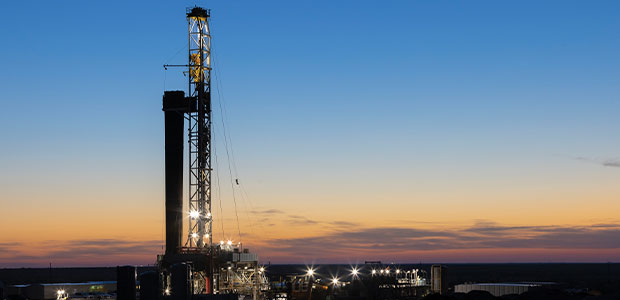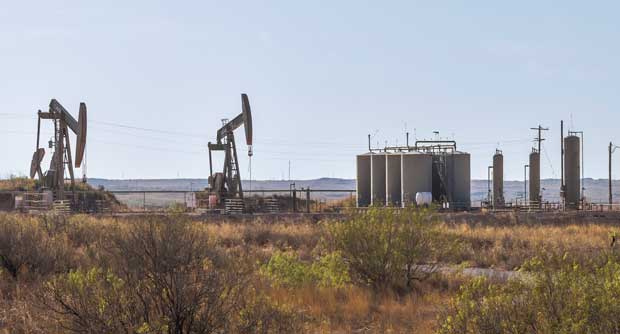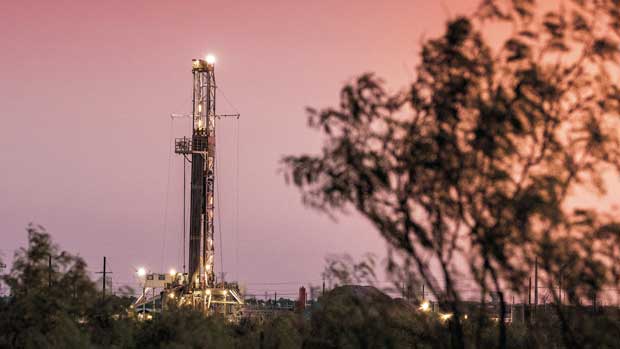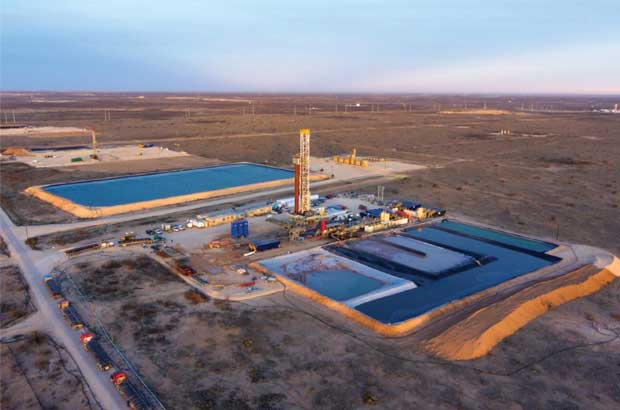
Permian Basin Operators Driving Oil, Gas Production To All-Time Highs
By Al Pickett, Special Correspondent
The numbers are staggering. The U.S. Energy Information Administration estimates that Permian crude oil production jumped by 78,000 barrels a day from July to August to reach 5.4 million barrels a day, while gas production soared 160 million cubic feet a day month over month to exceed 20 billion cubic feet a day.
In short, the basin is in a league of its own. From many of the most established producers in the game to the newly named, many of which sport management teams with extensive industry pedigrees, Permian players are positioned to maintain the upward trajectory.
Among the companies ramping up activity in the Permian is the new entity: Permian Resources Corporation. The company was created by a “merger of equals” between Denver-based Centennial Resource Development and Midland-based Colgate Energy Partners III.
Headquartered in Midland, publicly traded Permian Resources is focused in the core of the Delaware Basin, the western-most sub-basin within the Permian. With the completion of the merger on Sept. 1, the combined assets make Permian Resources the largest pure-play operator in the Delaware.
Sean Smith, Centennial’s chief executive officer, is serving as the combined company’s executive chairman, while Colgate’s Will Hickey and James Walter are serving as co-CEOs.
“Permian Resources brings together two successful companies, creating a better, stronger and more strategically compelling company. The combined asset base is highly complementary with a deep inventory of high-quality locations that generate robust free cash flow across commodity price cycles,” says Hickey. “Additionally, we are excited to establish Permian Resources’ headquarters in Midland, and are committed to being good stewards of the Permian Basin community in which we live, work and operate.”
“As significant owners of the business, we are closely aligned with shareholders and are focused on maximizing returns,” remarks Walter. “We are excited to continue our track record of generating robust cash-on-cash returns and returning capital to shareholders. The company’s capital return program is underpinned by our high-quality asset base, attractive growth profile, strong balance sheet and value-driven investment strategy.”
Permian Resources holds approximately 180,000 net acres, primarily in Reeves and Ward Counties in Texas and Eddy and Lea Counties on the New Mexico side of the state line, combining Colgate’s 105,000 net acres with 75,000 of Centennial’s net acres.
Best Shale Basin
“Our assets span both the northern and southern Delaware Basin and are strategically located in one of the most prolific, lowest break-even oil producing basins in the United States,” says Walter.
He says the Delaware is still in the “early innings” compared with other oil shale basins in the United States, citing the Delaware as the “least mature onshore tight oil basin.”
The newly formed Permian Resources Corporation, created by the merger of Centennial Resource Development and Colgate Energy Partners III, has a combined leasehold of approximately 180,000 net acres.
“There is a lot of opportunity for improvements to be made to deliver even greater value within the Delaware,” he adds. “The industry continues to identify new zones, optimize spacing and increase operational efficiencies.”
Another feature of the Delaware Basin is its stacked pay geology. “The Delaware is a deep basin, and we, along with the industry, have been successful exploring additional zones, both up hole and down hole.”
For example, he says the Wolfcamp intervals have historically been the most prolific target for the industry around Permian Resources’ operating area in the southern Delaware, but the “Third Bone Spring Sand has shown tremendous results over the past few years.”
With the Delaware’s stacked-pay characteristics, Walter says “Permian Resources’ differentiated inventory depth and asset quality support the company’s sustainable free cash flow profile, even at lower oil prices than today.”
He explains that the company continues “to focus on optimizing well design, spacing and completions techniques while driving higher operational efficiencies,” he adds.
Compared to when Colgate first began operating its first rig in the Southern Delaware Basin in 2018, its drilling and completion costs have reduced dramatically and “we continue to improve upon our operational efficiencies,” said Walter.
“Our goal is to be the Delaware Basin’s best pure-play company. There are great pure-play companies in other basins, but Permian Resources is unique in the Delaware, with a high-quality asset base and a deep inventory of premium locations to drive free cash flow growth and superior returns for investors.”
For the remainder of 2022, the company plans to operate an active development program of larger well packages with extended laterals to deliver total equivalent production of 140,000-150,000 barrels of oil equivalent a day (~52% oil) during the fourth quarter. For full-year 2023, Hickey says Permian Resources expects to spud and complete approximately 145 and 150 gross wells, respectively, with an average working interest of approximately 80% and 8/8ths net revenue interest of approximately 78%. The company plans to begin 2023 operating a seven-rig drilling program with the potential to reduce its rig count during the year, assuming expected operational efficiencies are achieved.
Based on planned activity levels, Permian Resources is targeting crude oil production growth of ~10% in the fourth quarter of 2023 compared with the fourth quarter of 2022. The development plan is estimated to generate approximately $1.1 billion-$1.3 billion of free cash flow for full-year 2023, assuming current strip prices.
Permian Resources expects its operating activity to be split relatively evenly between New Mexico and Texas. The company will focus the majority of its New Mexico activity in the Second and Third Bone Spring intervals, while its Texas development will concentrate in the Third Bone Spring and Wolfcamp intervals, according to Hickey.
“Our 2023 plan focuses on allocating capital in a way that maximizes capital efficiency,” Hickey explains. “Importantly, this will deliver an attractive production growth profile and significant free cash flow without having to add incremental rigs or completion crews in this challenging operational environment.”
Combined Permian Portfolio
Occidental is one of the largest acreage holders and a leading producer in the Permian Basin.
“With a position of approximately 2.8 million net acres in Texas and New Mexico, our combined Permian Basin portfolio of conventional and unconventional acreage differentiates us from our competitors,” says Richard Jackson, president of onshore resources and carbon management for Occidental.
Oxy has 16 gross operating rigs in the Midland Basin and on both the Texas and New Mexico sides of the Delaware Basin. Its projected third-quarter production in the Permian Basin is 523,000-533,000 boe/d.
“Occidental manages its Permian Basin operations through two business units: Oxy’s Permian Resources, which includes unconventional opportunities, and Oxy’s Permian EOR, which utilizes enhanced oil recovery techniques such as waterfloods and carbon dioxide floods,” explains Jackson. “Occidental has a leading position in the Permian, producing about 9% of total oil in the basin throughout 2021. By exploiting the natural synergies between both its business units, Occidental is able to deliver unique short- and long-term advantages, efficiencies, and expertise across its operations.”
Oxy’s Permian Resources’ unconventional oil development projects provide very short-cycle investment paybacks, averaging less than two years, according to Jackson.
“These investments contribute cash flow, while increasing long-term value and sustainability through higher return on capital employed,” he claims. Occidental’s oil and gas operations in the company’s Permian Resources “include approximately 1.4 million net acres. In 2021, well design processes, technologies and logistics improvements drove increased operational efficiencies, which helped lower the overall well cost while improving recovery.”
Occidental has 16 gross operating rigs in the Midland and Delaware basins. To simplify its supply chains and reduce truck traffic, the company has created a logistics and maintenance hub in Carlsbad, N.M., that supports drilling and completion activities.
Overall, Oxy Permian Resources produced from approximately 6,000 gross wells in 2021 and added 222 million boe to Occidental’s proved reserves through development and extensions of proved areas, he adds.
Meanwhile, the Permian Basin’s concentration of large conventional reservoirs, favorable CO2 flooding performance, and the expansive CO2 transportation and processing infrastructure results high-value enhanced oil production, Jackson points out.
“With 35 active CO2 floods and more than 50 years of experience, Occidental is the industry leader in Permian Basin CO2 flooding, which can increase ultimate oil recovery by 10%-25%,” he continues. “Technology improvements, such as the recent trend toward vertical expansion of the CO2 flooded interval into residual oil zone targets, continue to yield more recovery from existing projects.”
Oxy’s Permian EOR unit produced from 14,100 gross wells in 2021, and Jackson says the Permian EOR business consists of approximately 20,000 gross wells (injectors, producers, idle and active wells, EOR waterflood wells and CO2 water-alternating-gas wells). The company stores up to 20 million metric tons of CO2 annually.
“Currently, the CO2 in our operations primarily comes from natural underground sources, with an increasing volume coming from anthropogenic sources,” he offers. “Over time, our plan is to utilize larger volumes of anthropogenic CO2 captured from industrial sources and from direct air capture. By utilizing anthropogenic CO2 in the EOR process, we have the capability to produce net-zero or even negative oil. Oxy has more than five decades of experience in utilizing CO2 EOR in the Permian.”
Aventine Hub
Located outside Carlsbad, N.M., Occidental’s Aventine is the first integrated logistics-and-maintenance hub in the Permian Basin, bringing facilities for sand, drilling services and equipment, and cement together in one facility.
“The hub’s central location has increased transportation efficiency and reduced heavy-haul traffic, eliminating more than 4 million miles of truck traffic since operations began,” Jackson relates. “Aventine produces a competitive advantage by giving our operations real-time, cost-effective access to mission-critical supplies.”
Jackson says the Permian is a critical part of Oxy’s long-term corporate strategy, which includes a leadership position with carbon capture, utilization and storage (CCUS) and carbon management.
Speaking at the company’s 2022 Low Carbon Ventures Investors update last spring, Chief Executive Officer Vicki Holub said Occidental has spent years developing its strategy and building its CCUS platform that supports a future net-zero economy.
“A central part of that plan is direct air capture, which is critical to meeting Paris agreement targets, by enabling rapid emission reduction and low-carbon product development,” she explained. “Another key aspect of our vision is centralized sequestration hubs for large-volume CO2 storage. These hubs will be able to sequester CO2 from both industrial point-source projects and direct air capture. Direct air capture is synergistic with existing OxyChem and CO2 EOR operations.”
She noted that direct air capture CO2 also can be used in Oxy’s EOR operations to produce a net-zero oil product.
Jackson says the Permian Basin will be home to Oxy’s first direct air capture facility, expected to be in operation in late 2024.
Longer Laterals
Apache Corp. has a large leasehold position in the Permian Basin with operations in the Midland and Delaware basins, as well as the Central Basin Platform. David Pursell, executive vice president for development, says Apache’s total U.S. operations span 3.9 million gross (1.8 million net) acres, although the Permian is the only region in the country where Apache is currently drilling.
Pursell points out that Apache is running four drilling rigs with two in the southern Midland Basin and two in the Delaware Basin.
“The Permian Basin contains an enormous hydrocarbon system and is close to refining and export infrastructure along the Texas Gulf Coast,” he relates. “It is not surprising that this basin leads the United States in drilling activity.”
Apache Corp. is running two drilling rigs in the southern Midland Basin and two in the Delaware Basin, including one in the gas-rich Alpine High in Reeves County., Tx.
Apache is targeting longer laterals for its development programs with two-mile laterals as the norm, according to Pursell.
“But we are seeing success with three-mile laterals,” he acknowledges. “Our completion techniques vary across the basin. The common theme is a rigorous multidisciplinary subsurface characterization to matching landing zone, rock stresses in adjacent formations, offset well spacing and fracture stimulation size. We also incorporate fiber optic testing into our development programs to help calibrate the three-dimensional fracture stimulation growth. We have seen consistently better results.”
After completing two transactions that generated net proceeds of $1 billion, Apache closed a deal for total cost of $555 million on July 29 to acquire properties in the Texas Delaware Basin (primarily in Loving and Reeves counties) next to existing operations. Pursell says the acquired properties have a combination of producing wells, wells in the process of drilling and completion, and an inventory of undrilled locations.
According to Apache’s second-quarter earnings report, the acquisition also brings immediate access to a high-quality drilling rig and an experienced crew for ongoing development. The company expects production will average 12,000-14,000 boe/d for the remaining five months of the year.
“The Permian divestitures, along with the recent Texas Delaware acquisition, are part of an ongoing strategy to ‘core up’ our operations in the Permian,” Pursell emphasizes. “We have significant operations off shore in the North Sea and onshore Egypt and are making longer-cycle investments in Suriname. All areas compete for capital, and we have the ability to strategically or tactically shift our capital allocation to drive shareholder value.”
Alpine High
One of Apache’s two rigs currently drilling in the Delaware is operating in Alpine High, where Apache previously suspended drilling operations.
First announced in September 2016 to much fanfare, Apache estimated at the time that the field in Reeves Co., held 3 billion barrels of crude and 73 trillion cubic feet of natural gas. But it quickly became apparent that Alpine High was far richer in natural gas and its byproducts than the more valuable oil. As natural gas prices declined, Apache halted drilling activity.
“Alpine High is a large hydrocarbon system, both aerially and vertically, with a significant natural gas and oil resource,” Pursell comments. “We suspended drilling activity in 2019 with the collapse in ethane and propane prices. Although we discontinued new drilling at that time, operations and production have been ongoing. In the past two years, we analyzed data, tried new completion techniques, well spacing, etc. Tests resulted in better wells with higher EURs and longer plateaus. Given today’s high natural gas prices, and expectations that they may remain elevated, we are targeting a natural gas-prone portion of the play with one rig operating at Alpine High.
Pursell claims there is sufficient natural gas infrastructure, which is now operated by Kinetik Midstream, in the area.
“Alpine High competes very effectively within our portfolio,” he adds.
The company announced in March that it will invest a minimum of $100 million in the next 24 months for new well drilling and completion activity in Alpine High, where Kinetik has exclusive gas and NGL gathering and processing rights.
New Infrastructure
The Permian has experienced both the best and worst of times over the past decade, yet has continued to lead the world in production capacity growth. Since mid-2017, both oil and gas production have doubled across the basin, and that followed on the heels of a doubling of oil and gas output during the previous five year period from 2012 to 2017.
And the activity indicators show no signs of slowing. More than 45% of the active U.S. rigs are operating in the Permian, and 40% of all drilling permits issued in the United States this year are in West Texas and southeastern New Mexico. The same holds true for frac spreads, with the basin accounting for the lion’s share of frac activity. While strong commodity prices are sparking increased activity in all U.S. resource plays, no producing province on the planet can match the Permian’s growth barrel for barrel.
The EIA reports that U.S. natural gas pipeline exports from West Texas into Mexico have been growing, from 0.6 Bcf/d in 2019, to 1.2 Bcf/d in 2021, and to 1.4 Bcf/d on average from January through May 2022. The EIA attributed the growth in natural gas demand, particularly in Mexico’s power and industrial sectors, as contributing to the expanded Texas-to-Mexico pipeline exports.
To meet that increasing demand, five recently announced natural gas pipeline projects are expected to increase the Permian’s takeaway capacity by a combined 4.18 Bcf/d over the next two years.
The Matterhorn Express Pipeline, a joint venture among WhiteWater, EnLink Midstream, Devon Energy Corp. and MPLX, is a planned 490 mile pipeline that will be able to transport up to 2.5 Bcf/d of gas from the Waha Hub in West Texas to Katy, Tx. The pipeline, which will receive natural gas from upstream Permian connections and from direct connections at processing facilities in the Midland Basin, before connecting to the Agua Blanca Pipeline, is expected to enter service in the third quarter of 2024.
Three other projects, Kinder Morgan’s Gulf Coast Express Pipeline Expansion and Permian Highway Pipeline, and the Whistler Pipeline Capacity Expansion (a joint venture of WhiteWater and MPLX), are scheduled to come on line in the latter half of 2023. Those three expansions alone will increase takeaway capacity from the Permian Basin to South Texas markets from 1.62 Bcf/d to 7.70 Bcf/d
Meanwhile, the Oasis Pipeline Modernization Project is under construction and expected to enter service by the end of this year. It will optimize Energy Transfer’s existing Oasis Pipeline, providing an additional 0.06 Bcf/d of Permian takeaway capacity.
For other great articles about exploration, drilling, completions and production, subscribe to The American Oil & Gas Reporter and bookmark www.aogr.com.









